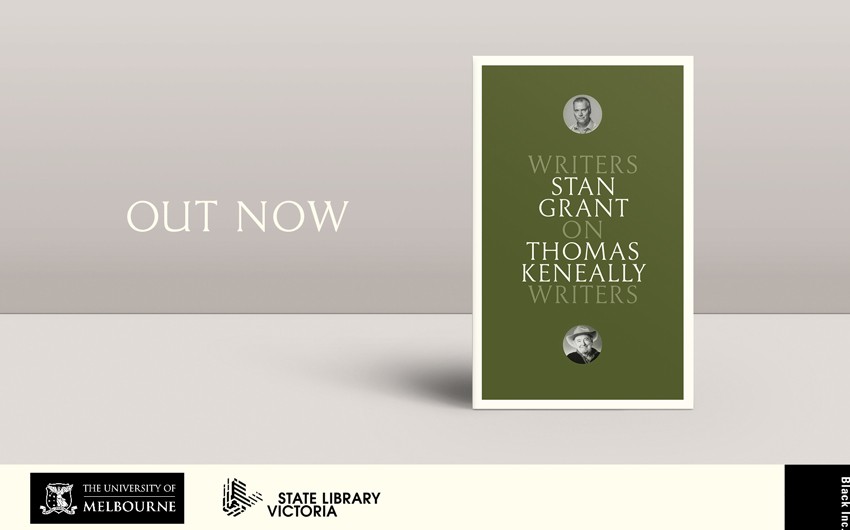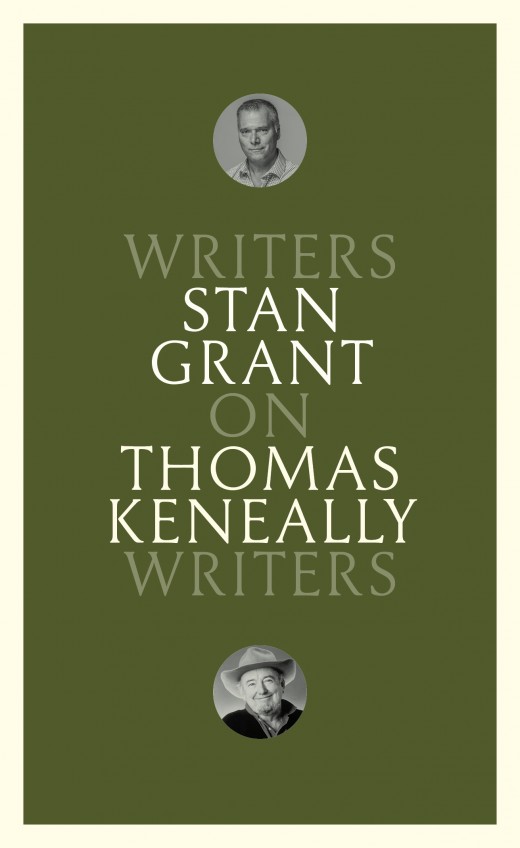News

News >
Read an extract: On Thomas Keneally
The latest in the Writers on Writers series is a thoughtful, nuanced look at Thomas Keneally’s The Chant of Jimmie Blacksmith by award-winning journalist Stan Grant, which considers race, representation and Australian history.
I believe in ghosts; my mother raised me on ghost stories. I would sit with her for hours at night as she told me about the white man on the horse, the old woman of the river, or the small man in the wheelchair who vanished right before her eyes. The world of spirits was so real to us because we lived in a time-between-time: in a world that, at once, was and is. You might call this the Dreaming, but that’s probably a bit exotic for the way I was raised.
The anthropologist William Stanner added an elusive, elegiac quality to this time-between- time with his neologism the ‘everywhen’. Stanner captured a timelessness that befits our haunted land. And that’s the word for me: haunted. It is not possible to sit in the still of this place we now call Australia and not be alive to all that has happened here. I was back on my father’s ancestral country recently and I felt it again – that moan that comes from the earth, especially when the light dims and people retreat back into the darkness.
Alone in this land, I know that time doesn’t move in a straight line. Like the distant call of birds or other animals, time itself echoes. There’s a different sound at night; it is the sound of absence. How could it not be? For tens of thousands of years, our earth and everything that lived and breathed on it heard the sound of a people, the rhythm of their speech, the patter of their feet coming and going on the ground, their songs and ceremony, and then, in what is in the span of humanity just the blink of an eye – there was silence. In a generation or two, my people were nearly extinguished. What does that do to a place? To lose its people and to witness unspeakable crimes. I think our country grieves, and in that grief a profound sadness remains. The lost souls form the spirit of the land itself. Mum was right: there are ghosts.
*
Before starting this essay, I went in search of a ghost: the ghost of Jimmy Governor. I went to the place where he took his last breath. The old Darlinghurst Gaol is now the site of the National Art School. The gallows are gone. But behind the high sandstone walls, it is not so hard to imagine what it was like, back then. I was taken through the time-worn corridors, past what once were cold prison cells. I turned a corner and stopped suddenly, like something – or someone – had grabbed hold of me. I looked up and my tour guide said, that’s where it happened. Exactly there, she said, where I was standing, is where Jimmy was hanged. Above me was where the trapdoor would have been, and where the hangman would have placed the noose around Jimmy’s neck.
Jimmy Governor was executed at 9 a.m. on 18 January 1901. The newspaper reported that he had slept well, had a good breakfast and walked to his death smoking a cigarette. A priest walked with him. Jimmy took the cigarette from his mouth; threw it away before the white hood covered his face. He tilted his neck – just slightly – to make it easier for the hangman to attach the noose. Death was instantaneous. There was hardly a tremor in the body, the reporter wrote. Jimmy Governor’s clothes were burned. He was buried beyond the prison walls.
Jimmy Governor killed children. He killed women. He took an axe to a family and then went on a rampage of theft, rape and murder. Nine people, he slaughtered – for slaughter it was. The most hunted man in the country. A man could earn himself a fortune for shooting Jimmy dead. Jimmy fantasised about being a bushranger like Ned Kelly. Ned was his hero. They shared some things in common: they were poor, rejected and exploited. But Jimmy’s image doesn’t lend itself to kitsch art and souvenirs. He would never be remembered like Ned. Jimmy belonged to the wretched of our earth – people Australia hoped would disappear, or be bred out.
Jimmy left no last words, not like Ned. ‘Such is life’: did Ned really say that? Does it matter? There’s a nation in those words. Ned gave us poetry and a philosophy: a devil-may-care stoicism. In death, Ned’s Irish Catholic rebelliousness is de-fanged, smoothed out until it becomes just a roguish charm: a Heath Ledger wink. But Jimmy Governor’s is a brooding presence and he leaves us in silence; there are no final words. He leaves behind a space for storytellers, and Jimmy is a tantalising subject. Jimmy’s epitaph is ours to write.
*
From our vantage point, Jimmy lived and died at the crossroads of history: he marked a moment between the old and the new. Between what was and what is yet to be: time-between-time. In books and film, storytellers have sought to cast Jimmy’s life and crimes as a morality play or a cri de coeur. Australia – its brutal treatment of Aboriginal people – has been put on trial as much as Jimmy himself. What Jimmy did was mon- strous, barbaric; no provocation could justify his violence. I know that is the correct moral reaction to the murder of innocent people, but I can’t let it rest there because he was pushed to this insanity, there is no doubt about that: cheated, humiliated and belittled. His white wife – a white wife, what was he thinking! – was scorned and laughed at for ‘living with savages’.
That’s what draws us to this story: not just the crime, but what the crime represents. Jimmy Governor has stood in for every one of my ancestors, and he put a face to my own rage. To me, conscious as I am of my family’s suffering, Jimmy’s execution has resonated not as an example of justice done, but as a reminder of the times that justice went undone – the slaughter of black people that was never prosecuted. No one is innocent. The story becomes a symbol of a ritual cleansing for a nation born in blood and murder: white blood and black blood smeared in one more act of a brutal frontier before we proclaimed a new nation.
Jimmy was executed less than three weeks after Federation, and here I am searching for him still, looking back into the past to try to make sense of who I am. More than a hundred years later, Jimmy Governor still casts a shadow over this nation. Jimmy Governor haunts me and he haunts Australia. This is a ghost story as Jacques Derrida would have seen it. He was on to some- thing when he coined the word ‘hauntology’, to describe how the traces of our past – our ghosts – throw shadows on our world. It is a tear in time, a crack in the fortress of modernity. The West thinks it can vanquish history; that the past can be entombed. History, we are told, is an arc of progress that bends towards freedom, and each generation shakes itself loose from the grip of its ancestors.
The Writers on Writers series is published by Black Inc. in association with the University of Melbourne and State Library Victoria. On Thomas Keneally is out now.
Share this post
About the author
Stan Grant is the ABC’s international affairs analyst, and vice-chancellor’s chair of Australian-Indigenous Belonging at Charles Sturt University. He won the 2015 Walkley Award for coverage of Indigenous affairs and is the author of On Thomas Keneally, The Australian Dream, Australia Day, The Tears of Strangers and Talking to My Country.
More about Stan Grant




